Abstract
Only 30% of all breast cancer can be explained by known risk factors. Increases in breast cancer incidence rates in Hawaii over the past few decades cannot be attributed solely to improvements in screening and detection. Avoidable environmental factors may contribute to a proportion of the unexplained cases. Emerging evidence on endocrine disruption suggests that environmental chemicals may play a role in the development of breast cancer. Agricultural chemicals, including endocrine disruptors, have been used intensively in Hawaii's island ecosystem over the past 40 years leaching into groundwater, and leading to unusually widespread occupational and general population exposures. This paper discusses breast cancer patterns in Hawaii in the context of documented episodes of exposure to two endocrine-disrupting chemicals, chlordane/heptachlor and 1,2-dibromo-3-chloropropane (DBCP), at levels that sometimes exceeded federal standards by several orders of magnitude. In light of this history, detailed geographic-based studies should be undertaken in Hawaii to elucidate the potential role of environmental factors in the development of breast cancer and other diseases.
Full text
PDF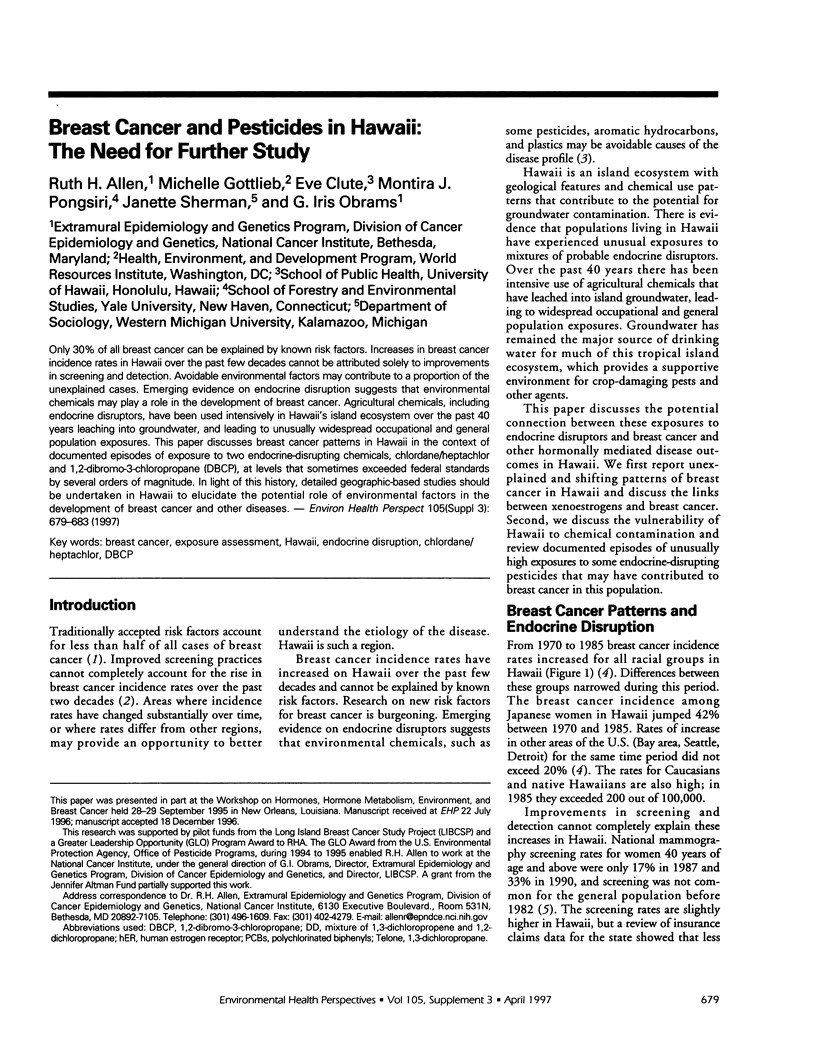
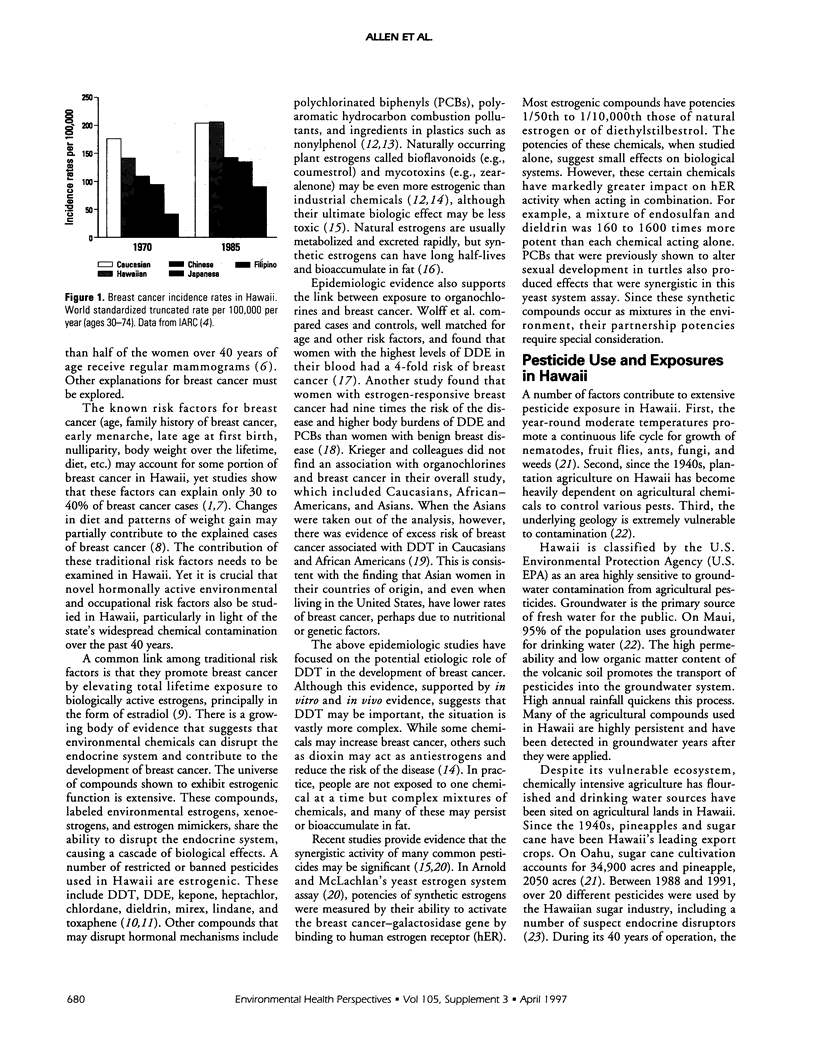
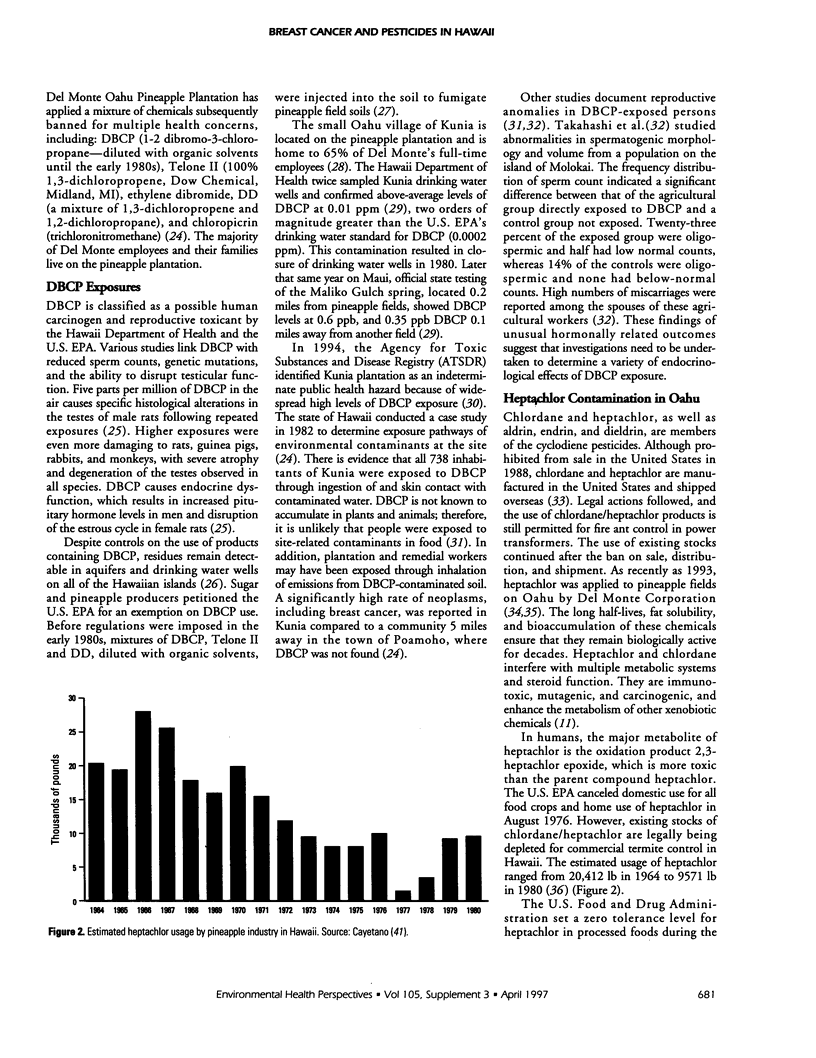
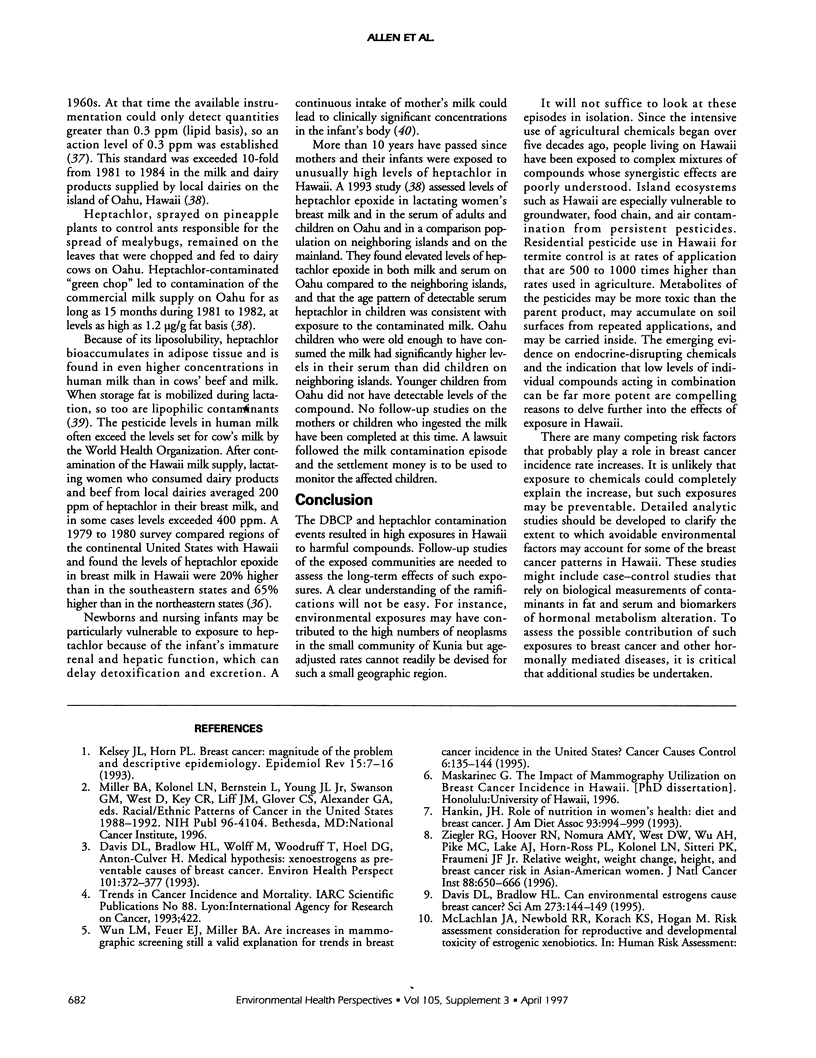
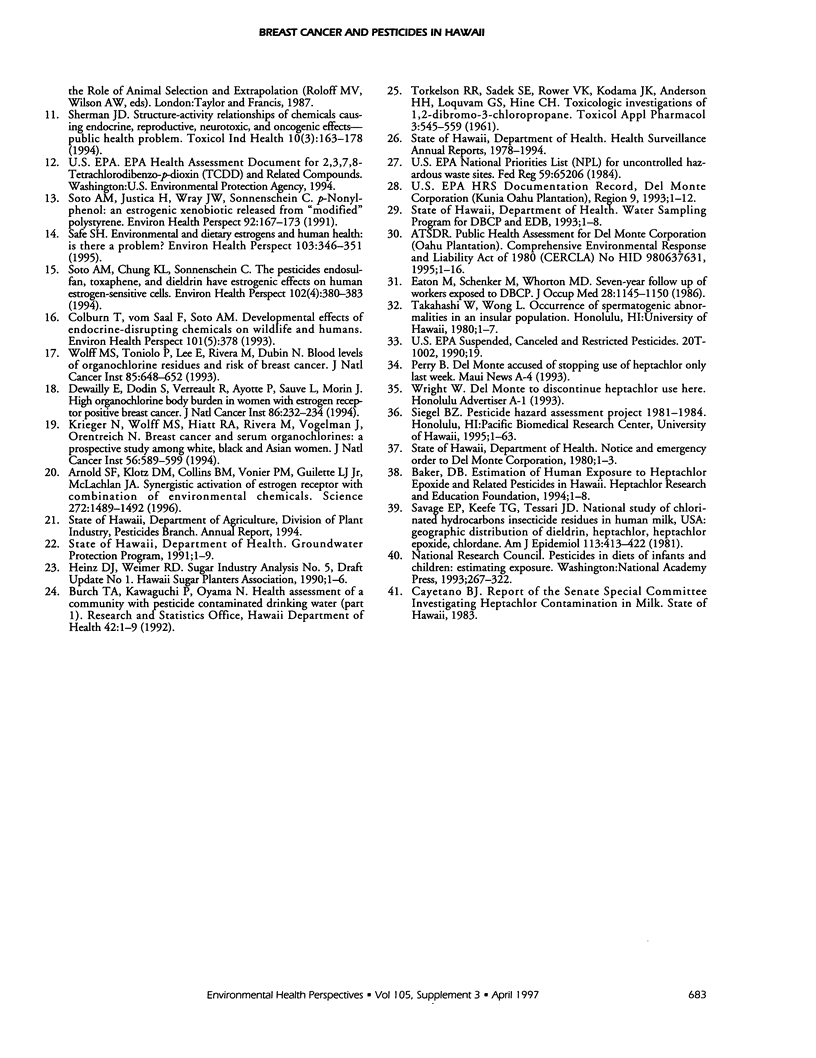
Selected References
These references are in PubMed. This may not be the complete list of references from this article.
- Arnold S. F., Klotz D. M., Collins B. M., Vonier P. M., Guillette L. J., Jr, McLachlan J. A. Synergistic activation of estrogen receptor with combinations of environmental chemicals. Science. 1996 Jun 7;272(5267):1489–1492. doi: 10.1126/science.272.5267.1489. [DOI] [PubMed] [Google Scholar]
- Colborn T., vom Saal F. S., Soto A. M. Developmental effects of endocrine-disrupting chemicals in wildlife and humans. Environ Health Perspect. 1993 Oct;101(5):378–384. doi: 10.1289/ehp.93101378. [DOI] [PMC free article] [PubMed] [Google Scholar]
- Davis D. L., Bradlow H. L., Wolff M., Woodruff T., Hoel D. G., Anton-Culver H. Medical hypothesis: xenoestrogens as preventable causes of breast cancer. Environ Health Perspect. 1993 Oct;101(5):372–377. doi: 10.1289/ehp.93101372. [DOI] [PMC free article] [PubMed] [Google Scholar]
- Dewailly E., Dodin S., Verreault R., Ayotte P., Sauvé L., Morin J., Brisson J. High organochlorine body burden in women with estrogen receptor-positive breast cancer. J Natl Cancer Inst. 1994 Feb 2;86(3):232–234. doi: 10.1093/jnci/86.3.232. [DOI] [PubMed] [Google Scholar]
- Eaton M., Schenker M., Whorton M. D., Samuels S., Perkins C., Overstreet J. Seven-year follow-up of workers exposed to 1,2-dibromo-3-chloropropane. J Occup Med. 1986 Nov;28(11):1145–1150. [PubMed] [Google Scholar]
- Hankin J. H. Role of nutrition in women's health: diet and breast cancer. J Am Diet Assoc. 1993 Sep;93(9):994–999. doi: 10.1016/0002-8223(93)92036-w. [DOI] [PubMed] [Google Scholar]
- Kelsey J. L., Horn-Ross P. L. Breast cancer: magnitude of the problem and descriptive epidemiology. Epidemiol Rev. 1993;15(1):7–16. doi: 10.1093/oxfordjournals.epirev.a036118. [DOI] [PubMed] [Google Scholar]
- Krieger N., Wolff M. S., Hiatt R. A., Rivera M., Vogelman J., Orentreich N. Breast cancer and serum organochlorines: a prospective study among white, black, and Asian women. J Natl Cancer Inst. 1994 Apr 20;86(8):589–599. doi: 10.1093/jnci/86.8.589. [DOI] [PubMed] [Google Scholar]
- Safe S. H. Environmental and dietary estrogens and human health: is there a problem? Environ Health Perspect. 1995 Apr;103(4):346–351. doi: 10.1289/ehp.95103346. [DOI] [PMC free article] [PubMed] [Google Scholar]
- Savage E. P., Keefe T. J., Tessari J. D., Wheeler H. W., Applehans F. M., Goes E. A., Ford S. A. National study of chlorinated hydrocarbon insecticide residues in human milk, USA. I. Geographic distribution of dieldrin, heptachlor, heptachlor epoxide, chlordane, oxychlordane, and mirex. Am J Epidemiol. 1981 Apr;113(4):413–422. doi: 10.1093/oxfordjournals.aje.a113109. [DOI] [PubMed] [Google Scholar]
- Sherman J. D. Structure-activity relationships of chemicals causing endocrine, reproductive, neurotoxic, and oncogenic effects--a public health problem. Toxicol Ind Health. 1994 May-Jun;10(3):163–179. doi: 10.1177/074823379401000306. [DOI] [PubMed] [Google Scholar]
- Soto A. M., Chung K. L., Sonnenschein C. The pesticides endosulfan, toxaphene, and dieldrin have estrogenic effects on human estrogen-sensitive cells. Environ Health Perspect. 1994 Apr;102(4):380–383. doi: 10.1289/ehp.94102380. [DOI] [PMC free article] [PubMed] [Google Scholar]
- Soto A. M., Justicia H., Wray J. W., Sonnenschein C. p-Nonyl-phenol: an estrogenic xenobiotic released from "modified" polystyrene. Environ Health Perspect. 1991 May;92:167–173. doi: 10.1289/ehp.9192167. [DOI] [PMC free article] [PubMed] [Google Scholar]
- TORKELSON T. R., SADEK S. E., ROWE V. K., KODAMA J. K., ANDERSON H. H., LOQUVAM G. S., HINE C. H. Toxicologic investigations of 1,2-dibromo-3-chloropropane. Toxicol Appl Pharmacol. 1961 Sep;3:545–559. doi: 10.1016/0041-008x(61)90045-x. [DOI] [PubMed] [Google Scholar]
- Wolff M. S., Toniolo P. G., Lee E. W., Rivera M., Dubin N. Blood levels of organochlorine residues and risk of breast cancer. J Natl Cancer Inst. 1993 Apr 21;85(8):648–652. doi: 10.1093/jnci/85.8.648. [DOI] [PubMed] [Google Scholar]
- Wun L. M., Feuer E. J., Miller B. A. Are increases in mammographic screening still a valid explanation for trends in breast cancer incidence in the United States? Cancer Causes Control. 1995 Mar;6(2):135–144. doi: 10.1007/BF00052774. [DOI] [PubMed] [Google Scholar]
- Ziegler R. G., Hoover R. N., Nomura A. M., West D. W., Wu A. H., Pike M. C., Lake A. J., Horn-Ross P. L., Kolonel L. N., Siiteri P. K. Relative weight, weight change, height, and breast cancer risk in Asian-American women. J Natl Cancer Inst. 1996 May 15;88(10):650–660. doi: 10.1093/jnci/88.10.650. [DOI] [PubMed] [Google Scholar]


